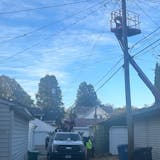The apartment boom underway in the Twin Cities is adding thousands of rentals across the metro area, from lavish lofts to trendy units inspired by feng shui. Only problem is, many people can't afford them.
Rents throughout the state are rising at the fastest clip in 12 years, meaning families of modest means have a tough time finding apartments. A recent report from the Minnesota Housing Partnership found there is a shortage of affordable units in 97 percent of all counties statewide, a problem that is expected to worsen as more luxury units come online.
"It's difficult to build rental housing that's affordable to renters who are most in need," according to Leigh Rosenberg, a housing research and outreach manager at the Minnesota Housing Partnership. "The need is so vast, we don't begin to touch the extent of what we really need."
The study found that the average rent in the Twin Cities stands at $979, nearly a 9 percent increase over the past three years. At the same time, competition for affordable units is rising. The average vacancy rate for the most affordable apartments — those that rent for less than $1,000 — dipped to 2 percent, down from 5 percent just three years ago.
"It's a massive and growing problem," said Alan Arthur, president and CEO of Aeon, a Twin Cities-based nonprofit housing provider.
The rental market has gone through a fundamental shift in the wake of the housing crash, creating more demand than the market can satisfy. With the housing market still in recovery, many people are still wary about buying a house, causing the share of renters to surge. Baby boomers are also putting pressure on supply as they are foregoing big houses in the suburbs for the ease and flexibility that comes with renting.
So far this year, developers have built more than 1,000 luxury rentals, many decked out with the amenities that were once associated only with condominiums. Many of those apartments are in the metro's most popular neighborhoods and are leasing up ahead of schedule.
Affordable housing is in short supply mostly because there's a lack of public and private funding available for income-restricted projects. But rising costs for land and materials also are pushing up prices for apartments. Units in popular locations can rent for $2 or more per square foot.


